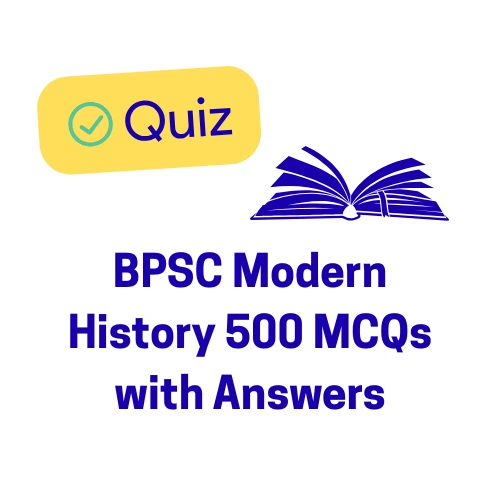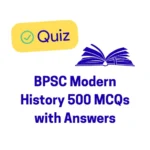BPSC Modern History Part 9 (500 MCQs) focus on the Revolutionary Movements, Ghadar Movement, Home Rule League, Lucknow Pact, and the beginning of Gandhi’s phase (1907-1919).
BPSC Modern History Part 9 (500 MCQs)
Section U: Revolutionary Terrorism and Ghadar Movement
Q241. Which revolutionary organization was founded by V. D. Savarkar and his brother in 1899 as a secret society of revolutionaries?
(A) Anushilan Samiti
(B) Abhinav Bharat Society
(C) Jugantar
(D) Hindustan Republican Association (HRA)
Q242. The Alipore Bomb Case (1908) involved which prominent revolutionary leader who was later acquitted and turned to spiritualism?
(A) Barindra Kumar Ghosh
(B) Aurobindo Ghosh
(C) Jatin Das
(D) Prafulla Chaki
Q243. The assassination of two British officials, Rand and Ayerst, in Poona in 1897 was carried out by:
(A) Khudiram Bose and Prafulla Chaki
(B) V. D. Savarkar and Ganesh Savarkar
(C) Chapekar Brothers (Damodar and Balkrishna)
(D) Bhagat Singh and Sukhdev
Q244. The India House was a center for revolutionary activities in London, established by:
(A) V. D. Savarkar
(B) Lala Hardayal
(C) Shyamji Krishna Varma
(D) Madame Cama
Q245. Who was the revolutionary who famously unfurled the first version of the Indian flag at the International Socialist Conference in Stuttgart, Germany, in 1907?
(A) Sardar Singh Rana
(B) V. D. Savarkar
(C) Madame Bhikaji Cama
(D) Raja Mahendra Pratap
BPSC Modern History Part 9 (500 MCQs)
Q246. The Ghadar Party was formed in 1913 in San Francisco, USA. Who was its first President?
(A) Lala Hardayal
(B) Sohan Singh Bhakna
(C) Barkatullah
(D) Bhai Parmanand
Q247. The newspaper of the Ghadar Party, called ‘Ghadar’, was published in which of the following language(s)?
(A) Punjabi
(B) Urdu
(C) Gujarati
(D) More than one of the above
Q248. The Komagata Maru Incident (1914), which involved a Japanese ship carrying Indian immigrants, primarily highlighted which discriminatory law of Canada?
(A) Arms Act
(B) Continuous Journey Regulation
(C) Rowlatt Act
(D) Press Act
Q249. Which famous Bengali revolutionary leader was known as ‘Bagha Jatin’ (Tiger Jatin) for his bravery and was killed in a shootout with the police in 1915?
(A) Jatin Das
(B) Jatindra Nath Mukherjee
(C) Ras Bihari Bose
(D) Hemchandra Kanungo
Q250. Who was involved in the attempt to assassinate Viceroy Lord Hardinge II in the Delhi Conspiracy Case (1912)?
(A) Rash Behari Bose and Sachindra Nath Sanyal
(B) Bhagat Singh and Sukhdev
(C) V. D. Savarkar and K. B. Hedgewar
(D) Surya Sen and Ganesh Ghosh
Section V: Home Rule League and Lucknow Pact (1916)
Q251. The Home Rule League movement in India was inspired by the Home Rule movement of which country?
(A) United States
(B) Canada
(C) Ireland
(D) South Africa
Q252. The Home Rule League movement was launched in India in 1916 by:
Bal Gangadhar Tilak
Annie Besant
G. K. Gokhale
(A) 1 only
(B) 2 only
(C) 1 and 2 only
(D) 1, 2, and 3
Q253. Bal Gangadhar Tilak’s Home Rule League was headquartered at:
(A) Madras (Adyar)
(B) Bombay
(C) Poona (or Belgaum)
(D) Calcutta
(E) None of the above / More than one of the above
Answer: (C) Poona (or Belgaum)
Q254. The main objective of the Home Rule League Movement was to achieve:
(A) Purna Swaraj (Complete Independence)
(B) Self-Government for India within the British Empire (Dominion Status)
(C) Universal suffrage for all Indians
(D) Complete separation of the judiciary from the executive
Q255. The Lucknow Pact (1916) was an agreement signed between the Indian National Congress and which other political body?
(A) Hindu Mahasabha
(B) All India Muslim League
(C) Justice Party
(D) Sikh League
BPSC Modern History Part 9 (500 MCQs)
Q256. Who was the President of the Indian National Congress at the famous Lucknow Session (1916)?
(A) Annie Besant
(B) Ambika Charan Majumdar (A. C. Majumdar)
(C) Bal Gangadhar Tilak
(D) Muhammad Ali Jinnah
Q257. The Lucknow Pact (1916) was significant because it led to which major development in Indian politics?
(A) Gandhi’s entry into the national movement.
(B) Reunion of the Moderates and Extremists within the INC.
(C) Acceptance of the demand for Purna Swaraj.
(D) Announcement of the Montagu Declaration.
Q258. The Congress-League joint scheme demanded a constitutional reform that included:
(A) Full provincial autonomy.
(B) Introduction of responsible government at the center.
(C) The principle of separate electorates for Muslims.
(D) More than one of the above
Q259. Who played a key role in bringing the Congress and the Muslim League together for the Lucknow Pact?
(A) Mahatma Gandhi
(B) Bal Gangadhar Tilak and Muhammad Ali Jinnah
(C) G. K. Gokhale and Nawab Salimullah
(D) Annie Besant and Lord Hardinge
Q260. The Montagu Declaration (August Declaration) of 1917 promised the gradual development of:
(A) Dominion Status for India immediately.
(B) Self-governing institutions in India with a view to the progressive realization of responsible government.
(C) Purna Swaraj at the end of World War I.
(D) Complete provincial autonomy without central control.
Section W: Gandhi’s Early Satyagrahas (1917-1918)
Q261. Mahatma Gandhi returned to India from South Africa in which year?
(A) 1914
(B) 1915 (January 9)
(C) 1916
(D) 1918
Q262. The first Satyagraha launched by Mahatma Gandhi in India was the:
(A) Ahmedabad Mill Strike
(B) Kheda Satyagraha
(C) Champaran Satyagraha
(D) Rowlatt Satyagraha
Q263. The Champaran Satyagraha was launched against which oppressive system imposed by European planters on Indian farmers?
(A) Ryotwari System
(B) Mahalwari System
(C) Tinkathia System (cultivation of Indigo on 3/20th of the land)
(D) Permanent Settlement
Q264. Who among the following leaders persuaded Mahatma Gandhi to come to Champaran?
(A) Rajendra Prasad
(B) J. B. Kripalani
(C) Rajkumar Shukla
(D) Mazharul Haq
Q265. The Ahmedabad Mill Strike (1918) was fought over which specific issue?
(A) Demand for the abolition of land revenue.
(B) Demand for higher wages after the withdrawal of the ‘Plague Bonus’.
(C) Protest against the Rowlatt Act.
(D) Protest against the Tinkathia System.
BPSC Modern History Part 9 (500 MCQs)
Q266. Which Satyagraha saw Mahatma Gandhi use the weapon of hunger strike for the first time in India?
(A) Champaran Satyagraha
(B) Kheda Satyagraha
(C) Ahmedabad Mill Strike
(D) Rowlatt Satyagraha
Q267. The Kheda Satyagraha (1918) in Gujarat was launched by the peasants against the refusal of the government to remit land revenue despite:
(A) The rise in food prices.
(B) Poor crops and a famine-like situation.
(C) The Tinkathia System.
(D) The high demand for cash crops.
Q268. Who were the main associates of Gandhi in the Kheda Satyagraha?
(A) Rajendra Prasad and J. B. Kripalani
(B) Sardar Vallabhbhai Patel and Indulal Yagnik
(C) Mahadev Desai and Narhari Parikh
(D) More than one of the above
Q269. The period from 1917 to 1918, marked by Gandhi’s three successful local struggles (Champaran, Ahmedabad, Kheda), is significant because it:
(A) Established Gandhi as a national leader of immense stature.
(B) Led to the immediate attainment of Purna Swaraj.
(C) Ended the Home Rule League Movement.
(D) Resulted in the unity of Moderates and Extremists.
Q270. Which event caused the revolutionary Rash Behari Bose to flee India and continue his revolutionary activities from Japan?
(A) Alipore Bomb Case
(B) Delhi Conspiracy Case (Attempt on Viceroy Hardinge)
(C) Lahore Conspiracy Case
(D) Komagata Maru Incident

